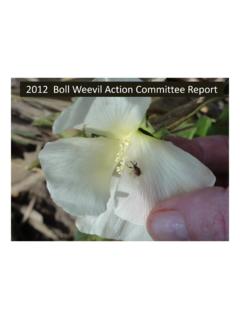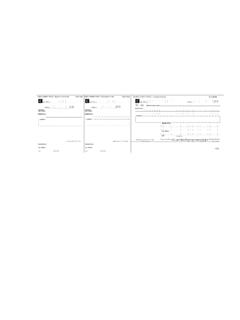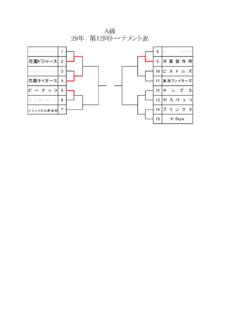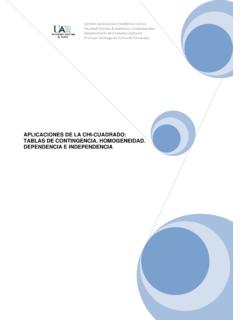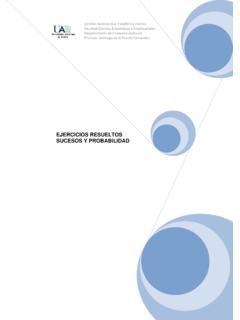Transcription of contRibutions - Structural Equations
1 October 2005 283 Commentaryco n tR i b u t i o n sInterpreting the Results from Multiple Regression and Stru tural Equation ModelsThe coefficients that are associated with pathways in multiple regression, as well as more advanced methods based on regression, such as Structural equa-tion models, are central to the interpretations made by researchers. The complex of factors that influence these coefficients make interpretations tricky and nonintuitive at times. Very often, inappropriate infer-ences are made for a variety of reasons. In this pa-per we discuss several important issues that relate to the interpretation of regression and path coefficients. We begin with a consideration of multiple regression. Here we discuss the different types of coefficients that can be obtained and their interpretations, with our focus on the contrast between unstandardized and standardized coefficients. Structural equation model-ing is used to show how models that better match the theoretical relations among variables can enhance in-terpretability and lead to quite different conclusions.
2 Here we again emphasize often-ignored aspects of the use of standardized coefficients. An alternative means of standardization based on the relevant ranges of variables is discussed as a means of standardization that can enhance have long used multiple regression in its various forms to examine relationships among explanatory and response variables. Over the past decade and a half, there has been a steady increase in the use of path analysis by biologists to serve the same purpose, but in the context of a more interpretive structure. Most recently, there has developed a consid-erable amount of interest in the more comprehensive capabilities of Structural equation modeling (SEM) for understanding natural systems, again with the purpose of enhancing our interpretation of results. These meth-odologies have in common that they are based on the fundamental principles of regression and share many of the same issues when it comes to interpretation. Researchers may not be aware that there has been a long history of discussion among quantitative social scientists and statisticians about the interpretation of results from both multiple regression and path analy-sis applications.
3 The topic is sufficiently subtle and important that the central theme of Pedhazur s (1997) book on regression is the pitfalls of interpreting re-sults. Among the many things he concludes is that re-sults are frequently misinterpreted, particularly as they relate to the meaning of path coefficients. Many of these same issues apply to SEM. This discussion has involved a consideration of many topics, including the types of coefficients that can be calculated, the kinds of interpretations that can be supported using differ-ent coefficient types, and the importance of theory to interpretation. Here we illustrate some of these issues and discuss problems with the use of standardized co-efficients, as well as a possible Bulletin of the Ecological Society of AmericaUnstandardized coefficientsFig. 1A presents the unstandardized path coef-ficients associated with the regression of plant cover on elevation, stand age, and fire severity. While the unstandardized coefficients are the most primary pa-rameters obtained from a multiple regression, often they are not presented by investigators.
4 In fact, typi-cally the significance tests associated with regression are tests of the unstandardized parameters, and the standardized parameters are simply derived from the unstandardized coefficients and not directly tested. Characteristic of unstandardized parameters, they are expressed in the original units of the explanatory and An illustrative exampleTo illustrate the points being made in this paper we consider an example dealing with the response of shrublands to wildfire in Southern California (J. B. Grace and J. E. Keeley, unpublished manuscript). The data presented here represent a small subset of the variables in the complete study. In addition, the rela-tionships among variables have been modified some-what to meet the needs of the current paper. In this example, 90 sites were located in areas burned by a series of fires that occurred during a 2-week period in the fall of 1993 (Keeley et al., in press). Plots were es-tablished in all 90 sites and sampling began in spring of the first postfire year and continued for 4 more years, though only the data from the first sampling fol-lowing fire are discussed here.
5 At each site, the vari-ables included (1) herbaceous cover (as a percentage of ground surface), (2) fire severity (based on skeletal remains of shrubs, specifically the average diameter of the smallest twigs remaining), (3) prefire stand age (in years), estimated from ring counts of stem samples, and (4) the elevation above sea level of the site. The data used in this analysis are summarized in Table 1. Again, the data presented are a subset of the original, and some relations in the data have been modified to make the example more applicable to our related to multiple regressionA multiple regression represents a particular mod-el of relationships in which all potential explanatory variables (predictors) are treated as coequal and their interrelations are unanalyzed. As we shall see, the ability to obtain interpretable results from such models depends on the degree to which their structure match-es the true relations among variables. Fig. 1 presents diagrammatic representations of a multiple regression model in which fire severity, stand age, and elevation are related to vegetation cover.
6 Parameter estimates were obtained using the software Mplus (Muth n and Muth n 2005) under maximum likelihood estimation. Several types of coefficients were obtained from the analyses and are presented in Fig. 1, with each subfig-ure presenting a different view of the relations among variables. Fig. 1. Multiple regression results based on analysis of the data in Table 1. (A) Unstandardized parameters. (B) Standardized parameters. (C) Semipartial co-efficients for the directional pathways. October 2005 285dependent variables. With reference to a simple lin-ear regression, unstandardized coefficients associated with directed paths represent the slope of the relation-ship. The same is true in multiple regression, although the slope is in n-dimensional space. As we begin to interpret the results in Fig. 1A, note that the undirected relationships (double-headed arrows) represent the covariances among exogenous variables (predictors) in a model. In contrast, the co-efficients associated with directed paths are partial regression coefficients.
7 It is important for the discus-sion that follows to understand when the principles of partial regression apply. Simply put, partial regression represents a method of statistical control that removes the effect of correlated influences. Pathways that in-volve partial regression can be recognized by the fol-lowing: (1) they involve a directed relationship (sin-gle-headed arrow), (2) the response variable (variable receiving the arrow) also receives other arrows, and (3) the multiple predictors affecting the response vari-able are correlated. As we can see from these criteria, all directed paths in multiple regression will involve partial regression as long as there are significant cor-relations among predictors. The question then is how are we to interpret such literal definition of a partial regression coef-ficient is the expected change in the dependent vari-able associated with a unit change in a given predic-tor while controlling for the correlated effects of other predictors.
8 There are actually several different ways we can look at partial regression coefficients. The most direct is to view them as parameters of an equa-tion such as cover = (elevation) + (age) (severity) (1)when variables are in their raw units. If we were able to plot a four-dimensional graph of cover against el-evation, age, and severity, the unstandardized regres-sion coefficients would be the slopes of the relation-ship in the plot. From this perspective, it should be clear that the coefficients estimate the mean influenc-es of predictors on the response variable and the varia-tion around the mean is ignored. Deviations from the mean in this case relate to the estimation of the prob-abilities that coefficients values are zero. Thus, one interpretation of the unstandardized coefficients is that they are prediction coefficients. They also are descrip-tive coefficients in that they describe the association between cover and a one-unit change in the other vari-ables.
9 Hypothetically, these coefficients might also be viewed as explanatory. However, for such an interpre-tation to be valid, we must depend on the structure of the model to match the true dependencies among the predictors. As Pedhazur (1997:8) states, Explanation implies, first and foremost, a theoretical formulation about the nature of the relationships among the vari-ables under study. This point will be illustrated later in the paper when we discuss the Structural equation model results for these data. Referring back to our example, if we were to keep elevation constant for a set of plots, and the stands be-ing burned were of a fixed age, a one-unit difference in the fire severity is associated with an average dif-ference in cover of cover units ( , the cover of the postfire community would differ by ). Simi-larly, if we were able to apply a fire of fixed sever-ity while also holding stand age constant, a difference in elevation of 1000 m is associated with an expected difference of 38% in the postfire coefficientsLooking at Fig.
10 1A, we see that it is difficult to compare unstandardized coefficients among different pathways because the raw units are various. Cover varies in percentage points, elevation varies in meters, age varies in years, and fire severity varies in the units of an index based on the diameter of remaining twigs following fire. So, is a value of (the coefficient for elevation effects on cover) large or small relative to the effect of another factor? The standardization of the coefficients based on the standard deviations of the variables is the approach typically used to make coef-ficients comparable. In essence, this puts variables in standard deviation units, and in that sense the expected 286 Bulletin of the Ecological Society of Americaimpact of a standard deviation difference in one vari-able (say elevation) can be compared to a standard de-viation difference in another variable (say fire severi-ty). Though a convenient transformation, standardized regression coefficients are frequently misinterpreted, for reasons we will discuss next.


